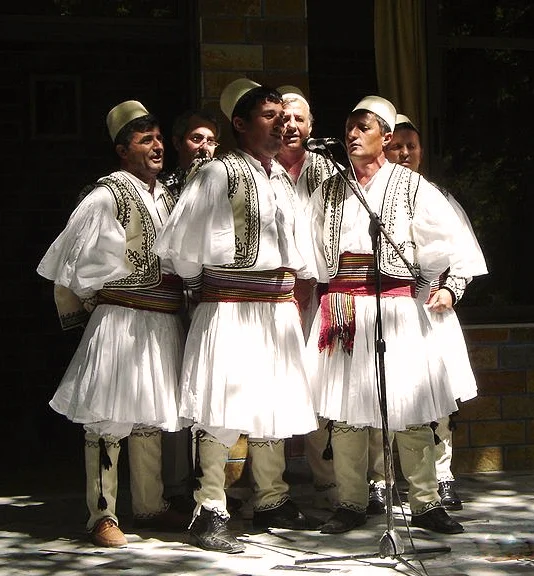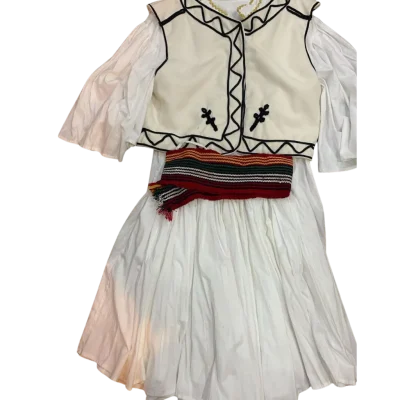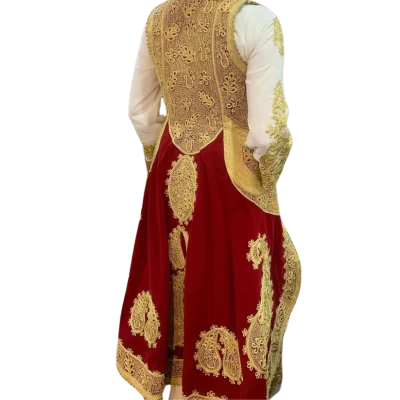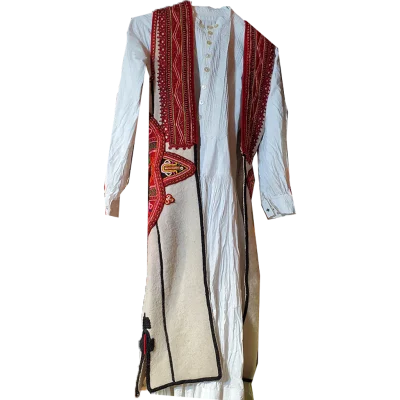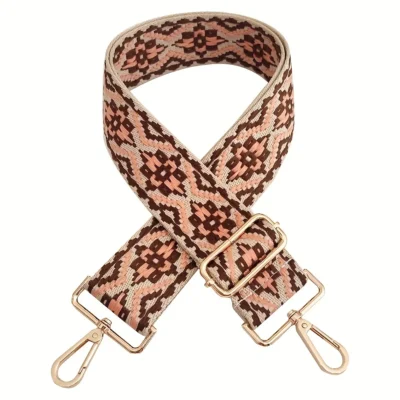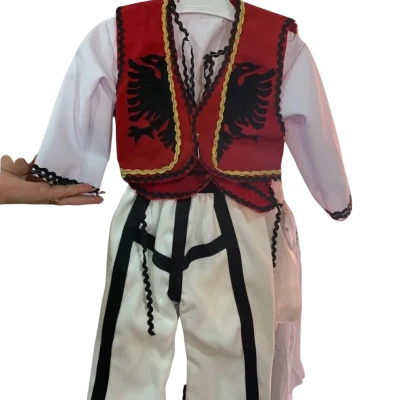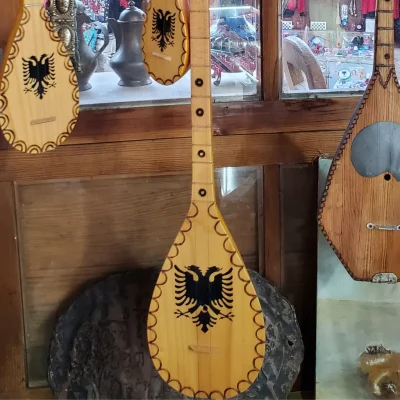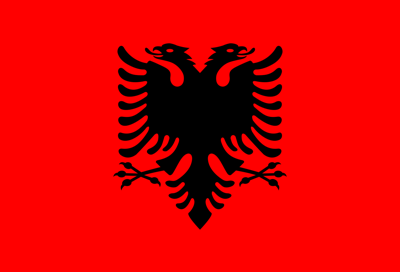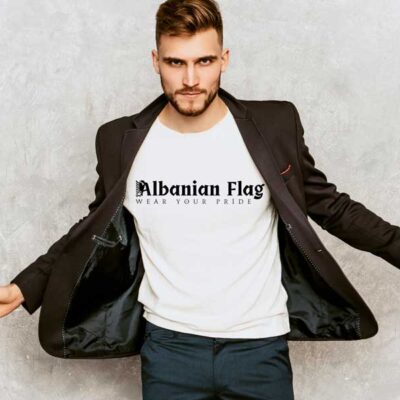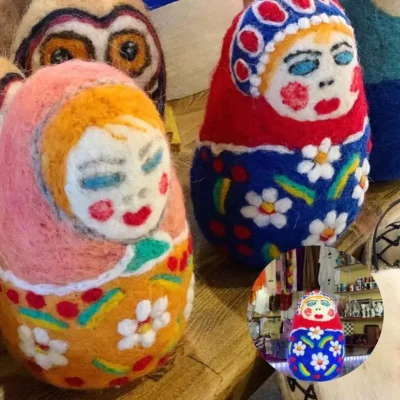Table of Contents
The fustanella is one of the most recognizable and significant pieces of Albanian traditional clothing. Worn primarily by men, this pleated, skirt-like garment has become a symbol of Albania’s rich cultural heritage, and it plays a crucial role in the Albanian national costume. With its distinctive design and historical importance, the fustanella is not just an article of clothing—it is a symbol of national pride, resilience, and bravery.
Historically, the fustanella has deep roots in Illyrian tradition and was used long before the Ottoman Empire came to the region. Over the centuries, it has been worn by Albanian warriors, notably during their battles against Ottoman forces, making it a powerful emblem of courage and resistance. The fustanella was also adopted by various Balkan cultures, such as the Greek Evzones, and became associated with the elite troops of both the Albanian and Greek military forces.
The fustanella is typically paired with other essential elements of Albanian traditional clothing, including the xhamadan (a traditional embroidered vest), çorape (knee-high socks or leggings), and opinga (traditional leather shoes). These accessories complete the look, transforming the fustanella into a full representation of Albanian national identity. Over time, the fustanella became associated with cultural ceremonies, folk dances, and Albanian weddings, serving not only as a practical garment but also as a ceremonial outfit.
Today, the fustanella remains an important part of Albanian cultural clothing, often worn during traditional festivals and national celebrations. It has even inspired modern fashion designers, who incorporate elements of fustanella into contemporary clothing lines, ensuring that this iconic garment continues to represent Albania’s proud heritage in the modern world.

Veshje tradicionale burrash (Jugu)
28,000.0 LOriginal price was: 28,000.0 L.26,000.0 LCurrent price is: 26,000.0 L.
Kostum popullor per burra (Jugu)
30,000.0 LOriginal price was: 30,000.0 L.28,600.0 LCurrent price is: 28,600.0 L.
Kostum popullor per femije (Vajza)
8,300.0 LOriginal price was: 8,300.0 L.7,800.0 LCurrent price is: 7,800.0 L.
Jelek me fije ari
83,000.0 LOriginal price was: 83,000.0 L.80,700.0 LCurrent price is: 80,700.0 L.
Jelek i kuq me fije ari
110,000.0 LOriginal price was: 110,000.0 L.104,000.0 LCurrent price is: 104,000.0 L.
Veshje e kompletuar Mirdite (100 vjecare)
35,000.0 LOriginal price was: 35,000.0 L.32,500.0 LCurrent price is: 32,500.0 L.
The History and Origins of Fustanella
The fustanella has a long and rich history, deeply rooted in the Illyrian and Balkan traditions. This pleated skirt-like garment is believed to have originated in the Illyrian era, as early as the 5th century BCE. Archaeological discoveries, such as the terracotta figurine found in Durrës, Albania, provide evidence of the fustanella’s use in the ancient world. Over time, the fustanella evolved from a simple garment into a symbol of power and status, particularly among Albanian warriors and soldiers.
Illyrian Influence on Fustanella
Many scholars believe that the fustanella originated from the Illyrian tunic, a traditional garment worn by the Illyrians—one of Albania’s ancient ancestors. This pleated tunic was designed to provide warmth in the colder climates of the Balkans. Over centuries, the fustanella’s design evolved to include more folds, creating the pleated look that defines it today. The fustanella was particularly favored by Albanian men due to its flexibility and the protection it offered during battle.
Archaeological Evidence of Fustanella in Albania
Historical records and archaeological finds further support the fustanella’s importance in Albanian culture. In Maribor, Slovenia, an Illyrian statue wearing a skirt-like garment was discovered, showing that similar clothing styles existed in the ancient Illyrian territories. The fustanella is also mentioned in a document from 1335, listing it as one of the items confiscated from a sailor in the Drin River region. Additionally, pottery fragments from Durrës depict men wearing fustanella-like garments, providing visual proof of its long-standing presence in Albanian history.
Fustanella in the Ottoman Period
The fustanella became even more prominent during the Ottoman period, as Albanian soldiers and warriors wore the garment while serving in the Ottoman army. Known for their bravery and combat skills, Albanian troops in the Ottoman Empire were often identified by their fustanella, and the garment became a symbol of Albanian warriors. Leaders such as Ali Pasha of Yanina and Muhammad Ali of Egypt famously wore the fustanella, further cementing its status as a garment of authority and power.
The fustanella was not only worn by military personnel but also by Albanian civilians, particularly in the southern regions of Albania, where it became a staple of Albanian traditional wear. During the 19th century, the fustanella spread across all Albanian territories, becoming the defining garment for Albanian men. Even after the decline of the Ottoman Empire, the fustanella remained a key part of Albanian national clothing, particularly during significant events such as weddings, national festivals, and cultural performances.
The Symbolism of Fustanella as a Warrior’s Garment
The fustanella has long been associated with warrior culture, bravery, and resistance. Albanian warriors, known for their military prowess, wore the fustanella during battles, including those against the Ottoman Empire. The garment was designed for flexibility and movement, making it ideal for combat. As a result, the fustanella became a symbol of Albanian courage and was adopted by elite military units both within and beyond the Ottoman Empire.
The fustanella’s role as a symbol of bravery extended beyond Albania, influencing the attire of other Balkan cultures. In Greece, the fustanella was worn by fighters during the Greek War of Independence and later became part of the Greek national costume. In modern times, it is worn by the Greek Evzones, ceremonial soldiers who guard the Tomb of the Unknown Soldier in Athens.
Key Elements of the Traditional Albanian Fustanella
The fustanella is not just a simple piece of clothing; it is a carefully crafted garment with intricate details that reflect the rich cultural heritage of Albania. The traditional Albanian fustanella consists of several key elements, each contributing to its iconic look and practical use. The design, construction, and accompanying accessories make it one of the most recognized symbols of Albanian traditional clothing.
The Design and Construction of Fustanella
The fustanella is characterized by its distinctive pleats, which give it a full and flowing appearance. Typically made from heavy, home-woven linen or wool, the pleats serve both aesthetic and practical purposes. Historically, the fustanella was designed to provide warmth and protection, especially in the colder mountainous regions of Northern Albania. The number of pleats in a traditional Albanian fustanella is symbolic, often representing key cultural or spiritual values. The Albanian fustanella usually has around sixty pleats, though the number may vary slightly depending on regional traditions.
The garment is often paired with a xhamadan—a sleeveless, embroidered vest made of wool or silk. The xhamadan adds an elegant touch to the fustanella and is intricately decorated with gold or silver thread, symbolizing wealth and social status. In colder regions, men also wear long-sleeved shirts, known as camish, under the xhamadan for extra warmth.
Pleating and Fabrics Used in Fustanella
The pleating process is a significant aspect of the fustanella’s design. Traditionally, the fabric is dipped in melted sheep-fat to make it waterproof and to help maintain the pleats. This process also gives the fustanella a slightly grayish appearance, which was practical for Albanian men-at-arms who needed their clothing to be durable and functional.
The fustanella is typically made from thick woolen or linen fabrics, ensuring durability and warmth. This is especially important in Northern Albania, where the climate can be harsh. The use of such fabrics not only makes the fustanella practical but also reinforces its cultural importance as a garment that connects Albanian men to their history of resilience and survival in challenging environments.
Accessories Worn with the Fustanella (Çorape, Xhamadan, Opinga)
To complete the traditional Albanian outfit, several accessories are worn alongside the fustanella. The most common of these are the çorape (knee-high socks or leggings), which are usually made from wool and are worn with the opinga (traditional leather shoes). Opinga shoes are soft leather footwear, often featuring turned-up points and sometimes adorned with pom-poms of black or red wool. These shoes are designed for flexibility, making them ideal for both everyday wear and combat.
The çorape are typically white and extend to just below the knee, complementing the pleated fustanella and adding to the overall aesthetic of the outfit. The çorape are usually fastened at the knee with straps or bands, adding both a practical and decorative element to the ensemble.
Additionally, a brez (traditional belt) is worn around the waist to secure the fustanella. This belt is often richly embroidered, adding a touch of elegance to the warrior’s outfit. Historically, men would carry weapons such as yataghans or pistols in their brez, reinforcing the fustanella’s association with warriors and defense.
Regional Variations of the Fustanella
The fustanella varies significantly across Albania, with distinct styles in Northern and Southern Albania. In Southern Albania—especially in Tosk regions—the fustanella is often longer, with more pleats, and worn with an embroidered vest and qeleshe (a fez-like hat). In contrast, in Northern Albania, the fustanella may be shorter and paired with tirqe (traditional Albanian pants) or other regional garments.
In some northern regions, the fustanella is reserved for formal occasions and is seen as a symbol of prestige. For example, Mirdita and Shkodra are known for their use of the fustanella during tribal meetings, dispute resolutions, and other ceremonial events. In contrast, in the southern regions, the fustanella is more commonly worn during weddings, festivals, and other celebrations.
The Role of Fustanella in Albanian Culture
The fustanella holds a prominent place in Albanian culture, symbolizing not only national pride but also the enduring spirit of Albania’s historical legacy. This traditional garment is more than just clothing; it serves as a visual representation of Albania’s rich history, its warriors’ bravery, and its deep-rooted cultural traditions. Throughout the centuries, the fustanella has remained a key element of Albanian identity, worn during significant national celebrations, cultural ceremonies, and by distinguished figures of Albanian history.
Fustanella as a Symbol of Albanian Identity
For centuries, the fustanella has been associated with Albanian national identity. Its role as part of the traditional attire worn by Albanian warriors during battles against the Ottoman Empire has solidified its status as a symbol of courage, strength, and resilience. The fustanella became particularly emblematic during the reign of Ali Pasha of Yanina and Muhammad Ali of Egypt, both of whom were famous Albanian leaders in the Ottoman era. The fustanella distinguished these figures as leaders and symbols of Albania’s fierce warrior tradition.
As a symbol of Albanian identity, the fustanella continues to be worn today at national events and ceremonies, reflecting a deep connection to the past. Whether it is during Independence Day celebrations or traditional Albanian weddings, the fustanella remains a visible marker of Albanian heritage.
Fustanella’s Role in Albanian Nationalism
In the 19th century, as movements for independence grew across the Balkans, the fustanella emerged as a significant symbol of Albanian nationalism. It was worn by fighters and freedom-seekers who sought independence from Ottoman rule, making the fustanella a garment of both pride and resistance. The spread of the fustanella to neighboring Balkan countries, such as Greece, further reinforced its role as a warrior’s attire. During the Greek War of Independence, many fighters wore the fustanella, a testament to its association with bravery and the fight for freedom.
Albanian fighters, known as trima (men-at-arms), were often identified by their fustanella, and the garment became a key part of the visual identity of Albanian resistance against foreign rule. Today, the fustanella is still used to honor those who fought for Albania’s independence, and it remains a symbol of Albanian nationalism.
Fustanella in Traditional Ceremonies and Festivals
The fustanella continues to play an important role in modern Albanian cultural celebrations. Worn during weddings, folk dances, and national holidays, the fustanella is a staple of Albanian traditional festivals. In Albanian weddings, particularly in the southern regions like Labëria, the fustanella is worn by grooms as a symbol of respect for cultural traditions and to honor their ancestors. The bride often complements the groom’s attire with her own traditional Albanian dress, making these ceremonies a celebration of both the union and the culture.
During festivals such as the Gjirokastër National Folklore Festival, performers don the fustanella as part of their Albanian folk clothing. The fustanella’s pleats, combined with the rhythmic movements of traditional Albanian dances, create a stunning visual display, drawing attention to the artistry and craftsmanship involved in creating this garment. These festivals keep the tradition alive, allowing the younger generation to stay connected to their roots.
The fustanella is also worn during national celebrations, such as Albania’s Independence Day and Flag Day, where men wear the garment to represent their patriotism. The fustanella’s role in these celebrations demonstrates its continued importance in Albanian cultural identity.
Albanian Accessories
Albanian Clothes for Kids
Albanian Instruments
Albanian Jewelry
Albanian Shoes
Albanian Traditional Dresses
Papuçe
Qeleshe (Traditional Skullcap)
Fustanella and Its Influence in the Balkans
The fustanella is not only a key element of Albanian traditional clothing but also a significant cultural garment that has influenced other parts of the Balkans. Worn by men in various Balkan regions, including Greece, North Macedonia, and Bulgaria, the fustanella became a symbol of masculinity, bravery, and national pride. Its use in both Albania and Greece has made it a shared cultural symbol, with both countries considering it part of their national identity.
Fustanella in Greece and Other Balkan Countries
While the fustanella is deeply tied to Albanian identity, it has also played a prominent role in other Balkan cultures, particularly in Greece. During the Greek War of Independence in the 1820s, many revolutionary fighters wore the fustanella, which became a powerful symbol of resistance against the Ottoman Empire. Albanian warriors, known for their military prowess, influenced the spread of the fustanella into Greek traditional attire.
Following Greek independence, the fustanella was adopted by the newly formed Greek army, and in 1835, it became the official court costume under King Otto of Greece. The fustanella later evolved into the uniform for the Greek Evzones, the ceremonial guards who still wear the garment as part of their uniform when guarding the Tomb of the Unknown Soldier in Athens. The fustanella became synonymous with Greek heroism, despite its Albanian origins, and is now an integral part of the Greek national dress.
The Greek War of Independence and the Spread of Fustanella
The influence of Albanian fustanella on the Greek War of Independence is well documented. Albanian fighters, who played a significant role in the early battles, brought their traditional clothing with them, including the fustanella. Greek klephts (bandit-rebels) and armatoles (militia men) adopted the fustanella for its practicality in mountain warfare, as well as its association with warrior culture. As a result, the fustanella became a visual symbol of Greek resistance and bravery during the war.
This cultural exchange between Albanians and Greeks helped solidify the fustanella’s status as a garment of courage and heroism, and it spread throughout the Balkans, influencing other groups who wanted to evoke the same sense of strength and independence.
Fustanella in Greek Evzones and Albanian Royal Guard
Both Albania and Greece have embraced the fustanella as a national symbol. In Albania, the fustanella was worn by the Royal Guard in the early 20th century, during the reign of King Zog I. The fustanella became a key element of the Albanian royal uniform, representing Albania’s connection to its warrior past and its cultural identity.
In Greece, the Evzones, the elite ceremonial unit of the Greek Presidential Guard, continue to wear the fustanella as part of their uniform. Their version of the fustanella has more pleats than the Albanian version, often numbering up to 400 pleats, each symbolizing a year of Ottoman occupation. This tradition of wearing the fustanella as part of the military uniform highlights the garment’s enduring connection to national pride and heroism in both Albania and Greece.
Fustanella’s Role in Other Balkan Cultures
The influence of the fustanella extended to other Balkan countries, including North Macedonia and Bulgaria. In North Macedonia, the fustanella was worn in regions like Prespa and Tikveš, where it became a part of the traditional dress, particularly during cultural events. Similarly, in Bulgaria, the fustanella became popular among young men who admired its connection to bravery and heroism, despite not being directly involved in independence movements. The spread of the fustanella across the Balkans reflects its powerful status as a symbol of masculinity and courage.
The Decline and Revival of Fustanella
The fustanella, once a staple of Albanian traditional clothing and widely worn across the Balkans, experienced a decline in everyday use as Albania and neighboring regions modernized. However, the garment never truly disappeared and has seen a revival in recent years, both as a symbol of national identity and in contemporary fashion.
The Shift Toward Western Clothing in Albania
In the early 20th century, with the influence of Western fashion, the wearing of the fustanella began to decline in Albania. This shift was particularly noticeable in urban areas, where Western-style suits, trousers, and coats became the norm for men. The younger generation, especially in the cities, favored these new styles, which they associated with modernity and progress. As a result, the fustanella became increasingly associated with rural areas and older generations, especially in Southern Albania, where it was still worn during significant cultural events.
The decline was also influenced by Albania’s political changes, as the country went through periods of isolation and authoritarian rule. During these times, Western-style clothing became more widespread, and traditional Albanian outfits like the fustanella were reserved for specific cultural or ceremonial occasions.
The Decline of Fustanella in the 20th Century
By the mid-20th century, the fustanella had largely fallen out of regular use in both Northern and Southern Albania. In some regions, it was replaced by tirqe or Western-style trousers, particularly among the Gheg communities of the north. In the south, where the fustanella had been a key part of the Tosk identity, it was gradually phased out in favor of modern clothing. The decline of the fustanella was part of a broader movement across the Balkans, where many traditional garments were replaced by Western fashions.
Despite this decline, the fustanella never fully disappeared. It remained a crucial part of Albanian cultural clothing, often worn during festivals, folk dances, and national holidays. The garment’s association with Albanian warriors and its symbolic connection to Albania’s past ensured that it would continue to be worn on important occasions, even as it faded from daily life.
The Modern Revival of Fustanella
In recent years, the fustanella has experienced a resurgence in popularity. Driven by a renewed interest in preserving Albanian cultural heritage, the fustanella is once again being worn with pride at national celebrations, cultural festivals, and weddings. The modern revival of the fustanella is part of a broader movement across Albania to reconnect with its rich cultural past.
The fustanella is now seen not only in traditional ceremonies but also in the world of contemporary fashion. Albanian designers are incorporating elements of the fustanella into modern clothing, creating collections that pay homage to the country’s cultural roots while appealing to a global audience. The pleated skirts, embroidered vests, and rich fabrics of the fustanella are being reimagined in a way that makes them accessible to a new generation of Albanians, ensuring that this iconic garment remains relevant in the 21st century.
Fustanella’s Appearance in Global Fashion and Cultural Performances
The fustanella has also made appearances on the global stage, featured in international fashion shows and cultural performances. Its bold, pleated design and historical significance make it a captivating symbol of Albanian identity. In recent years, the fustanella has been worn by performers at cultural events such as the Gjirokastër National Folklore Festival, where its use highlights the rich tradition of Albanian national clothes.
Furthermore, Albanian diaspora communities around the world continue to wear the fustanella during folk festivals and national celebrations, ensuring that the garment remains a key part of Albanian cultural identity no matter where Albanians live. From traditional opinga shoes to çorape socks, the entire outfit has become a symbol of cultural pride both in Albania and abroad.
Fustanella’s Legacy in Albanian and Balkan Culture
The fustanella is more than just a piece of traditional Albanian clothing—it is a living symbol of Albania’s deep-rooted cultural heritage, history, and identity. From its ancient Illyrian origins to its role in shaping Albanian nationalism, the fustanella has stood the test of time and continues to represent the bravery, resilience, and pride of the Albanian people.
Throughout history, the fustanella has been worn by Albanian warriors, symbolizing their courage and strength. It has also played a key role in shaping the national identities of neighboring Balkan countries like Greece, where it became part of the official military uniform for the Greek Evzones. In both Albania and Greece, the fustanella remains an important part of national dress, reflecting a shared history of resistance and independence.
Today, the fustanella is worn during national holidays, weddings, and folk festivals, serving as a bridge between the past and present. Whether in Albania, among the Albanian diaspora, or in neighboring Balkan countries, the fustanella continues to be celebrated as a powerful symbol of cultural heritage.
The Continued Importance of Preserving the Fustanella Tradition
Preserving the tradition of the fustanella is essential for maintaining Albania’s cultural identity. Efforts to reproduce the fustanella for modern fashion, cultural festivals, and ceremonial occasions are crucial in ensuring that this iconic garment remains relevant for future generations. Museums, cultural institutions, and designers alike are working to keep the fustanella alive, showcasing its historical significance while adapting it for contemporary audiences.
The fustanella‘s revival in both traditional Albanian attire and modern fashion demonstrates the enduring legacy of this garment. As Albanians continue to celebrate their heritage, the fustanella remains a visible reminder of the country’s proud history and its place in the Balkan region.

